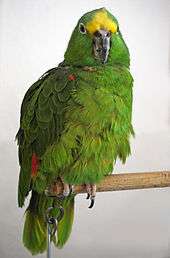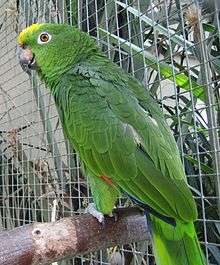Yellow-crowned amazon
| Yellow-crowned amazon | |
|---|---|
_-Well_Place_Zoo-4c.jpg) | |
| At Well Place Zoo, England | |
| Scientific classification | |
| Kingdom: | Animalia |
| Phylum: | Chordata |
| Class: | Aves |
| Order: | Psittaciformes |
| Family: | Psittacidae |
| Genus: | Amazona |
| Species: | A. ochrocephala |
| Binomial name | |
| Amazona ochrocephala (Gmelin, 1788) | |
The yellow-crowned amazon or yellow-crowned parrot (Amazona ochrocephala) is a species of parrot native to tropical South America and Panama. The taxonomy is highly complex, and the yellow-headed (A. oratrix) and yellow-naped amazon (A. auropalliata) are sometimes considered subspecies of the yellow-crowned amazon. Except in the taxonomic section, the following deals only with the nominate group (including subspecies xantholaema, nattereri and panamensis).
Description

Subspecies in the nominate group (including subspecies xantholaema, nattereri and panamensis) have a total length of 33–38 cm (13–15 in). As most other amazon parrots, it has a short squarish tail and primarily green plumage. It has dark blue tips to the secondaries and primaries, and a red wing speculum, carpal edge (leading edge of the wing at the "shoulder") and base of the outer tail-feathers.[2] The red and dark blue sections are often difficult to see when the bird is perched, while the red base of the outer tail-feathers only infrequently can be seen under normal viewing conditions in the wild.[3] The amount of yellow to the head varies, with nominate, nattereri and panamensis having yellow restricted to the crown-region (occasionally with a few random feathers around the eyes[3]), while the subspecies xantholaema has most of the head yellow.[2] All have a white eye-ring. They have a dark bill with a large horn (gray) or reddish spot on the upper mandible except panamensis, which has a horn colored beak. Males and females do not differ in plumage. Except for the wing speculum, juveniles have little yellow and red to the plumage.[2]
Habitat and distribution
The yellow-crowned amazon is found in the Amazon basin and Guianas, with additional populations in north-western South America and Panama. It has been introduced to Grand Cayman. It is a bird of tropical forest (both humid and dry), woodland, mangroves, savanna and may also be found on cultivated land and suburban areas. In the southern part of its range, it is rarely found far from the Amazon rainforest. It is mainly a lowland bird, but has locally been recorded up to 800 m (2600 ft) along on the eastern slopes of the Andes.[4]
Behaviour
Food and feeding
They are normally found in pairs or small flocks up to 30, but larger groups may gather at clay licks. Their food includes fruits, nuts, seeds and berries.[5] Foods with sugar and a large amount of salt can be dangerous for them.
Breeding
The nest is in a hollow in a tree, palm or termitarium, where they lay two to three eggs.[2] The incubation time is about 26 days, and the chicks leave the nest about 60 days from hatching.[5][6]
Taxonomy

The Amazona ochrocephala complex, which has been described as "a taxonomic headache",[7] is considered a single species by some authorities and split into three species, A. ochrocephala (yellow-crowned amazon), A. auropalliata (yellow-naped amazon) and A. oratrix (yellow-headed amazon), by others. The split is mainly based on the amount of yellow in the plumage, the color of the legs and bill, the close proximity of the oratrix group and auropalliata group in Oaxaca, Mexico, without apparent interbreeding,[8] and the presence of members of both the nominate group and the auropalliata group in northern Honduras.[9] This evaluation has, however, been confused by misunderstandings regarding the plumage variations in the populations in northern Honduras, where birds vary greatly in amount of yellow on the head, crown and nape, but have pale bills and a juvenile plumage matching the oratrix group, but neither the nominate nor the auropalliata group.[7][10] The taxon caribaea from the Bay Islands is a member of the auropalliata group, and occurs in relatively close proximity to the members of the oratrix group. As caribaea may have a relatively pale lower mandible, this could indicating a level of gene flow between this and the nearby taxa of the oratrix group.[11] If confirmed, this could suggest that the two are better considered conspecific. Alternatively, it has been suggested that caribaea and parvipes, both typically placed in the auropalliata group, may be closer to the oratrix than they are to the auropalliata sensu stricto. Both are relatively small and have red to the shoulder as in the members of the oratrix group, but unlike auropalliata sensu stricto.[7][10]
The members of this complex are known to hybridize in captivity,[7] and recent phylogenetic analysis of DNA did not support the split into the three "traditional" biological species, but did reveal three clades, which potentially could be split into three phylogenetic species: A Mexican and Central American species (incl. panamensis, which extends slightly into South America), a species of northern South America (northern nominate), and a species from the southern Amazon basin (nattereri, xantholaema and southern nominate).[12] The Central American clade can potentially be split further, with panamensis and tresmariae recognized as two monotypic species. The members of the clade from the southern Amazon basin should arguably be included as subspecies of the blue-fronted amazon, as they are closer to each other than to the northern clades.[12][13][14] Disregarding these problems, the following taxa are part of the Amazona ochrocephala complex as traditionally delimited:[2]
- nominate group ("true" yellow-crowned amazon):
- Amazona o. ochrocephala: East-central and south-eastern Colombia, Venezuela, Trinidad, Guyana, Suriname, French Guiana and the northern and eastern Amazon basin in Brazil.
- Amazona o. xantholaema: Marajó Island, in the Amazon River delta of north-eastern Brazil.
- Amazona o. nattereri: Far south-eastern Colombia, eastern Ecuador, eastern Peru, northern Bolivia and south-western Amazon basin of Brazil (east to around Mato Grosso). Often included in A. o. ochrocephala.[5]
- Amazona o. panamensis: Western Panama to north-western Colombia; sometimes called the Panama amazon
- auropalliata group (yellow-naped amazon):
- Amazona a./o. auropalliata: Southern Mexico to north-western Costa Rica.
- Amazona a./o. parvipes: Mosquito Coast in eastern Honduras and north-eastern Nicaragua.
- Amazona a./o. caribaea: Bay Islands, Honduras.
- oratrix group (yellow-headed amazon):
- Amazona o./o. oratrix: Pacific and Gulf slopes of Mexico. Also a population in Stuttgart exists.
- Amazona o./o. tresmariae: Tres Marías Islands, off west-central Mexico.
- Amazona o./o. belizensis: Belize.
- Amazona o./o. hondurensis: Sula Valley, Honduras.
Of these, hondurensis was only recently described,[15] while the population in north-western Honduras and adjacent eastern Guatemala (near Puerto Barrios) resembles belizensis and commonly is included in that subspecies, but may actually represent an undescribed subspecies. It has sometimes been referred to as guatemalensis,[2] but until officially described, the name remains provisional. An additional subspecies, magna, has sometimes been recognized for the population on the Gulf slope of Mexico, but today most authorities consider it invalid, instead including this population in oratrix.[5][7][16]
Conservation
The yellow-crowned amazon is considered to be of least concern by BirdLife International, and consequently, also by IUCN. Although populations are believed to be in decline, they do not yet approach the threshold specified by BirdLife International to rate the species as near threatened. As is the case with most parrots, it is listed on appendix II of CITES.[17] It occurs in numerous protected areas, and remains fairly common throughout a large part of its range.[3][4]
References
- ↑ BirdLife International (2012). "Amazona ochrocephala". IUCN Red List of Threatened Species. Version 2013.2. International Union for Conservation of Nature. Retrieved 26 November 2013.
- 1 2 3 4 5 6 Juniper, T., & M. Parr. 1998. A Guide to the Parrots of the World. Pica Press, East Sussex. ISBN 1-873403-40-2
- 1 2 3 Steven Hilty (2003). Birds of Venezuela (2nd ed.). Princeton University Press. ISBN 0-691-02131-7.
- 1 2 Schulenberg, T., D. Stotz, D. Lane, J. O'Neill, & T. Parker III. 2007. Birds of Peru. Princeton University Press. ISBN 978-0-7136-8673-9
- 1 2 3 4 Collar, N. 1997. Amazona ochrocephala (Yellow-crowned parrot). Pp 473-474 in: del Hoyo, J., A. Elliott & J. Sargatal. Eds. 1997. Handbook of the Birds of the World. Vol. 4. Sangrouse to Cuckoos. Lynx Edicions, Barcelona. ISBN 84-87334-22-9
- ↑ Alderton, David (2003). The Ultimate Encyclopedia of Caged and Aviary Birds. London, England: Hermes House. p. 231. ISBN 1-84309-164-X.
- 1 2 3 4 5 Steve N. G. Howell & Sophie Webb (1995). A Guide to the Birds of Mexico and Northern Central America. Oxford University Press. ISBN 0-19-854012-4.
- ↑ Binford, L. (1989). A distributional survey of the birds of the Mexican state of Oaxaca. Ornithological Monographs. 43: 1–418.
- ↑ Monroe, B., Monroe, JR. & T. Howell. (1966). Geographic variation in Middle American parrots of the Amazona ochrocephala complex. Occasional Papers of the Museum of Zoology, no. 34. Louisiana State University, Baton Rouge.
- 1 2 Lousada, S., & S. Howell. 1996. Distribution, variation, and conservation of Yellow-headed Parrots in northern Central America. Cotinga 5: 46-53.
- ↑ Lousada, S. 1989. Amazona auropalliata caribaea: A new subspecies of parrot from the Bay Islands, northern Honduras. Bull. BOC 109: 232-235.
- 1 2 Eberhard, J., & E. Bermingham. 2004. Phylogeny and Biogeography of the Amazona ochrocephala (Aves: Psittacidae) Complex. Auk 121(2): 318-332
- ↑ Russello, M. A., & Amato, G. (2004). A molecular phylogeny of Amazona: implications for Neotropical parrot biogeography, taxonomy, and conservation. Molecular Phylogenetics and Evolution. 30(2): 421-437
- ↑ Ribas, C. C., Tavares, E. S., Yoshihara, C., & Miyaki C. Y. (2007). Phylogeny and biogeography of yellow-headed and blue-fronted parrots (Amazona ochrocephala and Amazona aestiva) with special reference to the South American taxa. Ibis 149: 564-574
- ↑ Lousada, S., & S. Howell. 1997. Amazona oratrix hondurensis: A new subspecies of parrot from the Sula Valley of northern Honduras. Bull. BOC 117: 203-223.
- ↑ Clements, J. 2007. The Clements Checklist of the Birds of the World. Christopher Helm. ISBN 978-0-7136-8695-1
- ↑ CITES listings. Retrieved on 2 February 2008
- Aguilar Héctor F. "Algunas Notas sobre el Loro Real Amazona ochrocephala (Gmelin) (Psittacidae: Pcittacinae. Arini)en Venezuela. Rev. Ecol. Lat. Am. 8(1): 17-39, 2001." (PDF). ISSN 1012-2494.
External links
| Wikimedia Commons has media related to Amazona ochrocephala. |
- Photos - Mangoverde World Bird Guide
